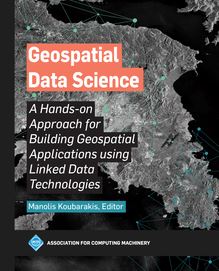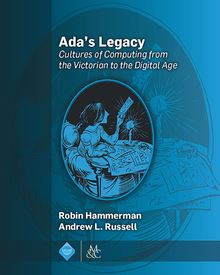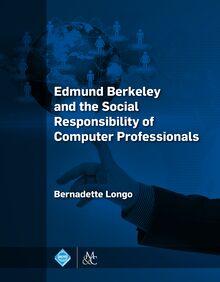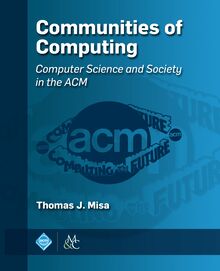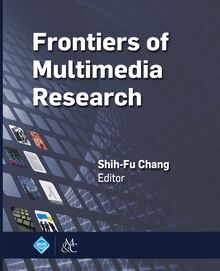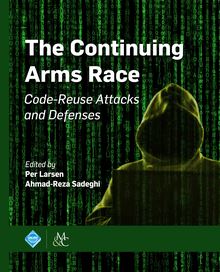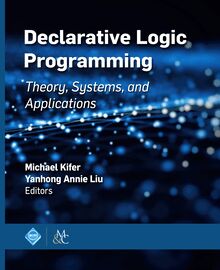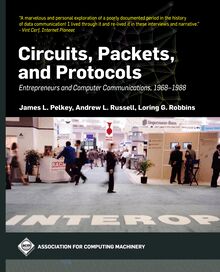-
 Univers
Univers
-
 Ebooks
Ebooks
-
 Livres audio
Livres audio
-
 Presse
Presse
-
 Podcasts
Podcasts
-
 BD
BD
-
 Documents
Documents
-
- Cours
- Révisions
- Ressources pédagogiques
- Sciences de l’éducation
- Manuels scolaires
- Langues
- Travaux de classe
- Annales de BEP
- Etudes supérieures
- Maternelle et primaire
- Fiches de lecture
- Orientation scolaire
- Méthodologie
- Corrigés de devoir
- Annales d’examens et concours
- Annales du bac
- Annales du brevet
- Rapports de stage
La lecture à portée de main
Vous pourrez modifier la taille du texte de cet ouvrage
Découvre YouScribe en t'inscrivant gratuitement
Je m'inscrisCommunities of Computing , livre ebook
Découvre YouScribe en t'inscrivant gratuitement
Je m'inscrisEn savoir plus
Vous pourrez modifier la taille du texte de cet ouvrage
En savoir plus

Description
Communities of Computing is the first book-length history of the Association for Computing Machinery (ACM), founded in 1947 and with a membership today of 100,000 worldwide. It profiles ACM's notable SIGs, active chapters, and individual members, setting ACM's history into a rich social and political context. The book's 12 core chapters are organized into three thematic sections. "Defining the Discipline" examines the 1960s and 1970s when the field of computer science was taking form at the National Science Foundation, Stanford University, and through ACM's notable efforts in education and curriculum standards. "Broadening the Profession" looks outward into the wider society as ACM engaged with social and political issues - and as members struggled with balancing a focus on scientific issues and awareness of the wider world.
Chapters examine the social turbulence surrounding the Vietnam War, debates about the women's movement, efforts for computing and community education, and international issues including professionalization and the Cold War. "Expanding Research Frontiers" profiles three areas of research activity where ACM members and ACM itself shaped notable advances in computing, including computer graphics, computer security, and hypertext.
Featuring insightful profiles of notable ACM leaders, such as Edmund Berkeley, George Forsythe, Jean Sammet, Peter Denning, and Kelly Gotlieb, and honest assessments of controversial episodes, the volume deals with compelling and complex issues involving ACM and computing. It is not a narrow organizational history of ACM committees and SIGS, although much information about them is given. All chapters are original works of research. Many chapters draw on archival records of ACM's headquarters, ACM SIGs, and ACM leaders. This volume makes a permanent contribution to documenting the history of ACM and understanding its central role in the history of computing.
Table of Contents / 1. ACM and the Computing Revolution (Thomas J. Misa) / Theme 1: Defining the Discipline / 2. From Handmaiden to 'Proper Intellectual Discipline': Creating a Scientific Identity for Computer Science in 1960s America (Janet Abbate) / 3. George Forsythe, the ACM, and the Creation of Computer Science As We Know It (Joseph November) / 4. Solving a Career Equation: The First Doctoral Women in Computer Science (Irina Nikivincze) / 5. The History and Purpose of Computing Curricula (1960s to 2000s) (Sebastian Dziallas) / Theme 2: Broadening the Profession / 6. 'Deeply Political and Social Issues': Debates within ACM 1965-1985 (Janet Toland) / 7. Organized Advocacy for Professional Women in Computing: Comparing Histories of the AWC and the ACM-W (Amy Sue Bix) / 8. The Development of Computer Professionalization in Canada (Scott Campbell) / 9. The Anatomy of an Encounter: Transnational Mediation and Discipline Building in Cold War Computer Science (Ksenia Tatarchenko) / 10. Concern for the 'Disadvantaged': ACM's Role in Training and Education for Communities of Color 1958-1975 (R. Arvid Nelsen) / Theme 3: Expanding Research Frontiers / 11. Other Places of Invention: Computer Graphics at the University of Utah (Jacob Gaboury) / 12. Framing Computer Security and Privacy, 1967-1992 (Rebecca Slayton) / 13. Hypertext, Digital Libraries, and Beyond: A History of SIGWEB (Inna Kouper) / Bibliography
Sujets
Informations
| Publié par | Association for Computing Machinery and Morgan & Claypool Publishers |
| Date de parution | 10 novembre 2016 |
| Nombre de lectures | 0 |
| EAN13 | 9781970001860 |
| Langue | English |
| Poids de l'ouvrage | 9 Mo |
Informations légales : prix de location à la page 0,2400€. Cette information est donnée uniquement à titre indicatif conformément à la législation en vigueur.
Extrait
Communities of Computing
ACM Books
Editor in Chief
M. Tamer zsu, University of Waterloo
ACM Books is a new series of high-quality books for the computer science community, published by ACM in collaboration with Morgan Claypool Publishers. ACM Books publications are widely distributed in both print and digital formats through booksellers and to libraries (and library consortia) and individual ACM members via the ACM Digital Library platform.
Communities of Computing: Computer Science and Society in the ACM
Thomas J. Misa, Editor, University of Minnesota 2017
Text Data Management and Analysis: A Practical Introduction to Information Retrieval and Text Mining
ChengXiang Zhai, University of Illinois at Urbana-Champaign Sean Massung, University of Illinois at Urbana-Champaign 2016
An Architecture for Fast and General Data Processing on Large Clusters
Matei Zaharia, Massachusetts Institute of Technology 2016
Reactive Internet Programming: State Chart XML in Action
Franck Barbier, University of Pau, France 2016
Verified Functional Programming in Agda
Aaron Stump, The University of Iowa 2016
The VR Book: Human-Centered Design for Virtual Reality
Jason Jerald, NextGen Interactions 2016
Ada s Legacy: Cultures of Computing from the Victorian to the Digital Age
Robin Hammerman, Stevens Institute of Technology Andrew L. Russell, Stevens Institute of Technology 2016
Edmund Berkeley and the Social Responsibility of Computer Professionals
Bernadette Longo, New Jersey Institute of Technology 2015
Candidate Multilinear Maps
Sanjam Garg, University of California, Berkeley 2015
Smarter than Their Machines: Oral Histories of Pioneers in Interactive Computing
John Cullinane, Northeastern University; Mossavar-Rahmani Center for Business and Government, John F. Kennedy School of Government, Harvard University 2015
A Framework for Scientific Discovery through Video Games
Seth Cooper, University of Washington 2014
Trust Extension as a Mechanism for Secure Code Execution on Commodity Computers
Bryan Jeffrey Parno, Microsoft Research 2014
Embracing Interference in Wireless Systems
Shyamnath Gollakota, University of Washington 2014
Communities of Computing
Computer Science and Society in the ACM
Thomas J. Misa, Editor
University of Minnesota
ACM Books #13
Copyright 2017 by the Association for Computing Machinery and Morgan Claypool Publishers
All rights reserved. No part of this publication may be reproduced, stored in a retrieval system, or transmitted in any form or by any means-electronic, mechanical, photocopy, recording, or any other except for brief quotations in printed reviews-without the prior permission of the publisher.
Designations used by companies to distinguish their products are often claimed as trademarks or registered trademarks. In all instances in which Morgan Claypool is aware of a claim, the product names appear in initial capital or all capital letters. Readers, however, should contact the appropriate companies for more complete information regarding trademarks and registration.
Communities of Computing
Thomas J. Misa, Editor
books.acm.org
www.morganclaypoolpublishers.com
ISBN: 978-1-97000-187-7 hardcover
ISBN: 978-1-97000-184-6 paperback
ISBN: 978-1-97000-185-3 ebook
ISBN: 978-1-97000-186-0 ePub
Series ISSN: 2374-6769 print 2374-6777 electronic
DOIs:
10.1145/2973856 Book
10.1145/2973856.2973857 Preface
10.1145/2973856.2973858 Chapter 1
10.1145/2973856.2973859 Chapter 2
10.1145/2973856.2973860 Chapter 3
10.1145/2973856.2973861 Chapter 4
10.1145/2973856.2973862 Chapter 5
10.1145/2973856.2973863 Chapter 6
10.1145/2973856.2973864 Chapter 7
10.1145/2973856.2973865 Chapter 8
10.1145/2973856.2973866 Chapter 9
10.1145/2973856.2973867 Chapter 10
10.1145/2973856.2973868 Chapter 11
10.1145/2973856.2973869 Chapter 12
10.1145/2973856.2973870 Chapter 13
10.1145/2973856.2973871 References
A publication in the ACM Books series, #13
Editor in Chief: M. Tamer zsu, University of Waterloo
Area Editor: Thomas J. Misa, University of Minnesota
First Edition
10 9 8 7 6 5 4 3 2 1
Contents
Preface
Chapter 1
ACM and the Computing Revolution
Thomas J. Misa
1.1
History in Computing
1.2
History of Computing
1.3
Chapters of ACM History
DEFINING THE DISCIPLINE
Chapter 2
From Handmaiden to Proper Intellectual Discipline : Creating a Scientific Identity for Computer Science in 1960s America
Janet Abbate
2.1
Introduction
2.2
The Status of Computing at NSF in the Early 1960s
2.3
Organizational Boundary-work: Getting a Seat at the Table
2.4
Discursive Boundary-Work: Establishing a Scientific Identity
2.5
Success: The Creation of NSF s Office of Computing Activities
2.6
Conclusion
2.7
Acknowledgments
Chapter 3
George Forsythe and the Creation of Computer Science As We Know It
Joseph November
3.1
The Man Who Would Remove the M from the ACM
3.2
Forsythe Before CS: From Mathematics to Meteorology to Computing
3.3
Hard Lessons on the Road to Computer Science
3.4
Building a Home for Computer Science at Stanford
3.5
Forsythe and the Challenge of Defining Computer Science
3.6
Conclusion
Chapter 4
Solving a Career Equation: The First Doctoral Women in Computer Science
Irina Nikivincze
4.1
Introduction
4.2
Historical Context
4.3
Gender and Science
4.4
Gender and Computing: Identifying the Problems
4.5
Data and Method
4.6
Findings
4.7
Conclusion
Chapter 5
The History and Purpose of Computing Curricula (1960s-2000s)
Sebastian Dziallas and Sally Fincher
5.1
Always Volunteers: Coordinating Volunteer Efforts
5.2
Accreditation: Addressing a Threat to the Reputation of the Discipline
5.3
Definition of a Discipline
5.4
Conclusion
5.5
Acknowledgments
BROADENING THE PROFESSION
Chapter 6
Deeply Political and Social Issues : Debates within ACM 1965-1985
Janet Toland
6.1
Introduction
6.2
1969: A Question of Importance
6.3
1972: The Equal Rights Amendment
6.4
1975: The Turchin Issue
6.5
The Committee on Computers and Public Policy
6.6
History of SIGCAS
6.7
Analysis of Changing Interests within SIGCAS
6.8
Conclusion
Appendix A
Chapter 7
Organized Advocacy for Professional Women in Computing: Comparing Histories of the AWC and ACM-W
Amy Sue Bix
7.1
Introduction
7.2
Gender, Computing, and Organized Advocacy for Women
7.3
Advocacy for Women in Computing and K-12 Outreach
7.4
The Shifting Nature of Advocacy for Women in Computers
7.5
Conclusion
Chapter 8
The Development of Computer Professionalization in Canada
Scott Campbell
8.1
Rise of Canadian Computing
8.2
ACM s Early Start in Canada
8.3
Canadian Computing and Data Processing Societies
8.4
The DPMA in Canada
8.5
CIPS, DPMA, and the Canadian Accreditation Battle
8.6
Toward Canadian Identity?
Chapter 9
The Anatomy of an Encounter: Transnational Mediation and Discipline Building in Cold War Computer Science
Ksenia Tatarchenko
9.1
Novosibirsk-Moscow-New York-San Francisco-Los Angeles
9.2
Person-to-Person, Institution-to-Institution, Discipline-to-Discipline
9.3
Twisted Truths: Dealing with Hazards of Boundary-Crossing
9.4
Conclusions: Divided Worlds, a Shared Community
Chapter 10
Concern for the Disadvantaged : ACM s Role in Training and Education for Communities of Color (1958-1975)
R. Arvid Nelsen
10.1
Introduction
10.2
The Discussion of Social Implications and Issues within the ACM
10.3
Programs for the Disadvantaged -1968-1972
10.4
ACM Involvement
10.5
ACM Establishes a National Committee on Computing and the Disadvantaged
10.6
Conclusion
EXPANDING RESEARCH FRONTIERS
Chapter 11
Other Places of Invention: Computer Graphics at the University of Utah
Jacob Gaboury
11.1
Introduction
11.2
Salt Lake City, 1966
11.3
Practical Applications
11.4
Problem Solving
11.5
Community
11.6
Other Places
Chapter 12
Framing Computer Security and Privacy, 1967-1992
Rebecca Slayton
12.1
Framing Record-Keeping Security
12.2
Transitions in the 1980s: Specialization and the Growth of Computer Networking
12.3
Reframing Security Amid Growing Computer Networking
12.4
Conclusion
Chapter 13
Hypertext, Digital Libraries, and Beyond: A History of ACM SIGWEB
Inna Kouper
13.1
Introduction
13.2
The Association for Computing Machinery (ACM)
13.3
ACM SIGWEB
13.4
Conclusion: Toward a Model of Epistemic Work in Professional Organizations
Acknowledgments
References
Index
Contributor Biographies
Preface
I like to think the origins of this volume stretch back to a visit that archivist Bruce Bruemmer made to Edmund Berkeley at his home in Newton, Massachusetts. Berkeley was well along in a busy and tumultuous life, as an author, activist, publisher, computer visionary, and co-founder of the Association for Computing Machinery. By my reckoning, he had then published three dozen books. He is of course most famous for the popular and readable Giant Brains, or Machines That Think (1949), but his first major work was published more than a decade earlier in 1937 by the American Institute of Actuaries. It was a 40-page treatise bearing the unwieldy title of Boolean algebra (the technique for manipulating and , or , not , and conditions) and applications to insurance. Remarkably, it was promptly reviewed in the Journal of Symbolic Logic by none other than Alonzo Church. Church was the eminent Princeton mathematician who, just a few months earlier, had recognized the unusual insight contained in a paper on computable numbers by a young Alan Turing (three years Berkeley s junior). In his review, Church praised Berkeley s exposition of Boolean algebra with illustrative examples worked out in detail and connected to insurance applications. He favorably compared Berkeley s examples to those given by logician John Venn. Church closed w
-
 Univers
Univers
-
 Ebooks
Ebooks
-
 Livres audio
Livres audio
-
 Presse
Presse
-
 Podcasts
Podcasts
-
 BD
BD
-
 Documents
Documents
-
Jeunesse
-
Littérature
-
Ressources professionnelles
-
Santé et bien-être
-
Savoirs
-
Education
-
Loisirs et hobbies
-
Art, musique et cinéma
-
Actualité et débat de société
-
Jeunesse
-
Littérature
-
Ressources professionnelles
-
Santé et bien-être
-
Savoirs
-
Education
-
Loisirs et hobbies
-
Art, musique et cinéma
-
Actualité et débat de société
-
Actualités
-
Lifestyle
-
Presse jeunesse
-
Presse professionnelle
-
Pratique
-
Presse sportive
-
Presse internationale
-
Culture & Médias
-
Action et Aventures
-
Science-fiction et Fantasy
-
Société
-
Jeunesse
-
Littérature
-
Ressources professionnelles
-
Santé et bien-être
-
Savoirs
-
Education
-
Loisirs et hobbies
-
Art, musique et cinéma
-
Actualité et débat de société
- Cours
- Révisions
- Ressources pédagogiques
- Sciences de l’éducation
- Manuels scolaires
- Langues
- Travaux de classe
- Annales de BEP
- Etudes supérieures
- Maternelle et primaire
- Fiches de lecture
- Orientation scolaire
- Méthodologie
- Corrigés de devoir
- Annales d’examens et concours
- Annales du bac
- Annales du brevet
- Rapports de stage
